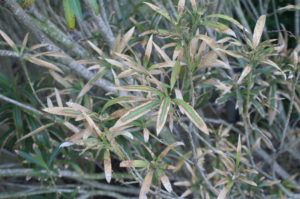 COMMON NAME: Oleander leaf scorch
COMMON NAME: Oleander leaf scorch
SCIENTIFIC NAME: Xylella fastidiosa
DISEASE DESCRIPTION
Bacterial leaf scorch caused by a bacterium Xylella fastidiosa was first reported on oleander in California in the 1990s. In 2004, this disease was reported in Texas. Since then, it has be found at various locations in Texas, including Galveston, Harlingen, Austin, San Antonio, and El Campo. BLS on oleander is just one of many diseases caused by X. fasitidiosa with common symptoms on other crops. These crops and landscape plants include oaks, elms, grapes, and blueberries.
*BONUS (Due to larger number of students in class, several were given assignment to write factsheet on these diseases). Check these out:
Bacterial Leaf Scorch on Blueberries
SYMPTOMS
Leaf scorch symptoms appear first on one or more branches as leaf yellowing and drooping, and soon the margins of the leaves turn a deeper yellow or brown and eventually die. As the disease develops, more branches are affected as the plant dies. This happens more quickly when the weather is hot and dry.
Symptoms of this disease are often confused with those caused by drought. However, under limited water conditions leaves on all branches of a healthy plant yellow and droop at the same time. Drought-stressed leaves yellow uniformly or along the central leaf vein, whereas in leaf scorch disease yellowing of leaves progresses from the tip or margins of leaves inward. Also, unless the drought is severe, the plant recovers when watered, while X. fastidiosa infected Oleander will not recover because bacteria limit the flow of water to the affected branches.
BIOLOGY
The disease is caused by Xylella fastidiosa. This bacterium resides in the xylem vessels (water-conducting channels) of the plant, where it multiplies and blocks these channels and eventually limits the flow of water and nutrients within the plant. The bacterium is transmitted and spread by xylem-feeding insects, such as sharp shooters, leaf hoppers or spittle bugs.
MANAGEMENT METHODS
There is no known cure for oleander leaf scorch. Pruning out the symptomatic parts of the plant may improve the appearance of the oleander tree or shrub but will not save the plant. The bacteria by then have already grown throughout the plant via the xylem. The removal of obviously symptomatic and dying oleanders immediately rather than just pruning unsightly branches will reduce the spread to other healthy oleander plants by the insect vectors.
RESOURCE LINKS*:
https://www.youtube.com/watch?v=gPl_7UXsQko
A detailed video about how to control Oleander Leaf Scorch
https://thesmartergardener.com/oleander-leaf-scorch-oleander-alternatives/
Useful information and replace suggestions.
https://apsjournals.apsnet.org/doi/10.1094/PDIS.2004.88.9.1049A?mobileUi=0
Publication about the first report in Texas
This factsheet is authored by Cheng Hu ( PhD student)
Factsheet information for the plant health issues represented by the images on the 2019 TPDDL calendar were written by graduate students enrolled in the Department of Plant Pathology & Microbiology PLPA601 Introductory Plant Pathology course in the 2018 Fall semester (course instructor: Dr. David Appel). This exercise provides an opportunity for a high impact learning activity where the students are tasked with producing an informational output directed to the general public and to provide opportunity for the students to write.